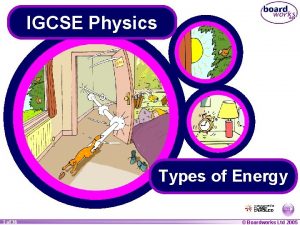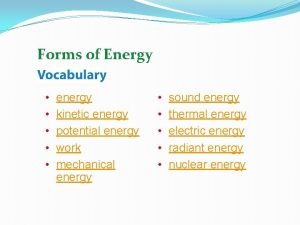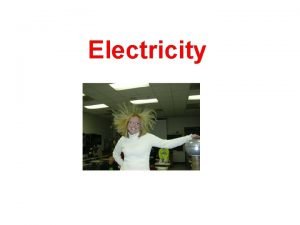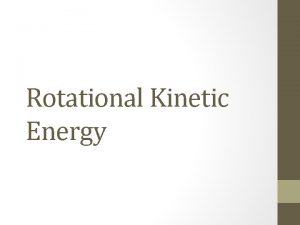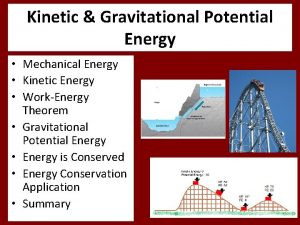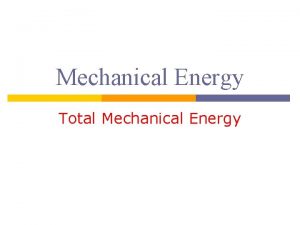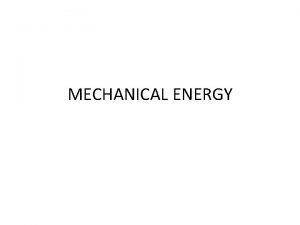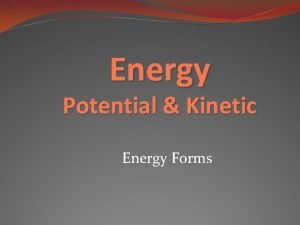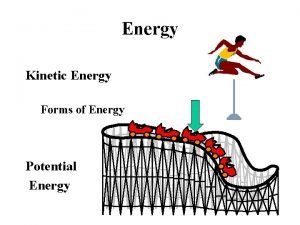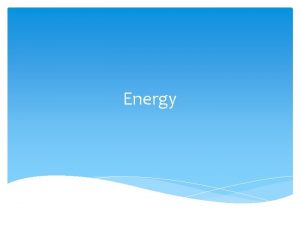Forms of mechanical energy Kinetic Energy energy associated





















- Slides: 21

Forms of mechanical energy • Kinetic Energy: energy associated with the motion. • Potential Energy: energy stored in a compressed spring or stretched elastic or in an object that is held at rest above the earths surface. • To change the energy, one need to do some “WORK”. –The amount of work is equal to the change of total energy. 1

Definition of Work • We all need to do some work in order to accomplish something each day. • More work is needed to carry 10 pizzas from Pizza Hut to your home than that for 1 pizza. (i. e. larger force is needed with equal distance). • More work is needed to drive yourself from Purdue to LA than that from Purdue to IND. (i. e. same force but longer distance). • Work = Force X distance • Unit: 1 joule = 1 N X 1 m • If Force points to the opposite direction of motion, work < 0, i. e. negative work. • Otherwise, work > 0, i. e. positive work. 2

Kinetic Energy associated with the object’s motion. • v = v 0 + at d = v 0 t +1/2 at 2 • F = ma, assume v 0 = 0. • W = Fd = ma(1/2 at 2) = ma(1/2 av 2/a 2) = ½ X mv 2 = Kinetic Energy In this case, the increase of kinetic energy (from zero) is equal to the amount of work done. 3

Ch 6 CP 2 100 kg crate accelerated by net force = 50 N applied for 4 s. How much work is done? A). 500 J B). 0. 005 J C). 50 J D). 200 J E). 4 J M Fnet c) W = Fd = (50 N)(4 m) = 200 J 7

quiz: 100 kg crate accelerated by net force = 50 N applied for 4 s. What’s the total final kinetic energy? A). 500 J B). 0. 005 J C). 50 J D). 200 J E). 4 J M Fnet 8

• If work is done but no kinetic energy is gained, we say that the potential energy has increased. Potential Energy – For example, if a force is applied to lift a crate, the gravitational potential energy of the crate has increased. – The work done is equal to the force (mg) times the distance lifted (height). – The gravitational potential energy equals mg X h. • potential energy implies storing energy to use later for other purposes. – For example, the gravitational potential energy of the crate can be converted to kinetic energy and used for other purposes • After releasing the string, it reach the ground with higher speed, i. e. large kinetic energy, if it’s positioned higher, i. e. higher potential energy at the beginning. 9

Ch 6 E 8 5. 0 kg box lifted (without acceleration) thru height of 2. 0 m What is increase in potential energy and how much work I Is needed ? A). 5000 J, 5000 J B). 490 J, 490 J C). 98 J, 98 J D). 196 J, 196 J E). 49 J, 49 J PE = mgh = (5. 0 kg)(9. 8 m/s 2)(2. 0 m) = 98 J b) F = ma = 0 = Flift – mg Flift = mg = (5. 0 kg)(9. 8 m/s 2) = 49 N W = Fd = (49 N)(2. 0 m) = 98 J 10

Conversion Between Potential and Kinetic energy • If we raise an object a height h so that it starts and finishes at rest then the average force = mg and the work done = mgh. This energy is stored as potential energy. • if the mass is allowed to fall back to it’s original point then • • v 2 = v 02 + 2 gh ½ mv 2 = ½ mv 02 + mgh, assume v 0 = 0 mgh = 1/2 mv 2 = KE • So the original work in lifting is stored and then returned as kinetic energy h F = mg g 11

1 M-01 Bowling Ball Pendulum A bowling ball attached to a wire is released like a pendulum Is it safe to stand here after I release the bowling ball ? mgh h 1/2 mv 2 mgh = 1/2 mv 2 • NO POSITIVE WORK IS DONE ON THE BALL • THUS, THERE IS NO GAIN IN TOTAL ENERGY • THE BALL WILL NOT GO HIGHER THAN THE INITIAL POSITION 12

1 M-01 Bowling Ball Pendulum A bowling ball attached to a wire is released like a pendulum Does the string tension do any work? A). Yes. B). No. mgh h 1/2 mv 2 mgh = 1/2 mv 2 13

1 M-03 Triple Chute Three Steel Balls travel down different Paths Each path is clearly different. Which ball will travel the farthest ? A). The one n the longer track B). The on the shorter track C). All three travel equal distance. D). Need to know the initial height 2/23/2021 14 14

1 M-08 Galileo Track Ball travels down one ramp and up a much steeper ramp Will the ball travel to a lower or higher height when going up the steeper, shorter ramp ? A). Higher B). Same height C) Lower D). Need to know the length of the slope Conservation of Energy: mgh = 1/2 mv 2 = mgh • AS THE BALL OSCILLATES BACK AND FORTH, THE HEIGHT IS REDUCED BY A LITTLE. WHAT MIGHT ACCOUNT FOR THIS? • FRICTION IS SMALL, BUT NOT ZERO. 2/23/2021 So, The Ball should return to the same height 15 15

1 M-10 Loop-the-Loop Ball travels through a Loop-the-Loop From what height should the ball be dropped to just clear the Loop-the-Loop ? Conservation of Energy: mgh = mg(2 R) + 1/2 mv 2 At the top of the loop N + mg = mv 2/r The minimum speed is when N = 0 Therefore h = 5/2 R (Friction means in practice H must be larger) 2/23/2021 16 16

Conversion Between Potential and Kinetic energy • An elastic force is a force that results from stretching or compressing an object, e. g. a spring. • When stretching a spring, the force from the spring is • F = -kx , where x is the distance stretched • The spring constant, k, is a number describing the stiffness of the spring. 17

18

Conversion Between Potential and Kinetic energy The increase in elastic potential energy is equal to the work done by the average force needed to stretch the spring. 19

Ch 6 E 10 To stretch a spring a distance of 0. 20 m, 40 J of work is done. What is the increase in potential energy? And What is the value of the spring constant k? A). PE = 40 J, k = 2000 n/m B). PE = 40 J/0. 2 m. K = 2000 n/m C). PE = 40 J, k = 200 n/m D). PR = 40 J*0. 7 m. K = 200 n/m x=0. 20 m equilibrium PE = ½ kx 2 k = 2 PE/x 2 = 80/(0. 2)2 - = 2000 n/m 2/23/2021 PE = 40 J 20 20

Ch 6 CP 4 A 0. 20 kg mass is oscillating horizontally on a friction -free table on a spring with a constant of k=240 N/m. The spring is originally stretched to 0. 12 m from equilibrium and released. What is its initial potential energy? A). 1. 73 J B). 17. 3 J C) 2. 75 J D). 275 J E). 12 J x=0. 12 m M PE = 1/2 kx 2 = ½(240)(0. 12)2 = 1. 73 J 21

Ch 6 CP 4 A 0. 20 kg mass is oscillating horizontally on a friction -free table on a spring with a constant of k=240 N/m. The spring is originally stretched to 0. 12 m from equilibrium and released. What is the maximum velocity of the mass? Where does it reach this maximum velocity? A). 1. 73 m/s B). 4. 16 m/s C) 3. 46 m/s D). 0. 765 m/s E). 12 m/s No friction so energy is conserved E=PE+KE, maximum KE when PE=0 KEmax = 1/2 mv 2 v = 4. 16 m/s. This occurs at the equilibrium position 22 22

Ch 6 CP 4 A 0. 20 kg mass is oscillating horizontally on a friction -free table on a spring with a constant of k=240 N/m. The spring is originally stretched to 0. 12 m from equilibrium and released. What are values of PE, KE and velocity of mass when the mass is 0. 06 m from equilibrium? x=0 A). PE = 0. 832 J, KE = 0. 9 J, v = 1. 6 m/s B). PE = 0. 482 J, KE = 1. 28 J, v = 3. 6 m/s C). PE = 0. 432 J, KE = 1. 3 J, v = 3. 6 m/s D). PE = 4. 32 J, KE = 1. 3 J, v = 36 m/s E). PE = 0. 432 J, KE = 13 J, v = 36 m/s x=0. 12 m M PE = 1/2 kx 2 = ½(240)(0. 06)2 = 0. 432 J Since total energy = 1. 73 J then the kinetic energy = 1. 73 – 0. 432 = 1. 3 J KE = 1/2 mv 2 = 1. 3 then v = 3. 6 m/s 23

Quiz: A lever is used to lift a rock. Will the work done by the person on the lever be greater than, less than, or equal to the work done by the lever on the rock? (assume no dissipative force, e. g. friction, in action). a) b) c) d) Greater than Less than Equal to Unable to tell from this graph 24
 Gravitational and kinetic energy
Gravitational and kinetic energy Mechanical energy
Mechanical energy Energy
Energy Why is potential energy highest at the top
Why is potential energy highest at the top Potential energy of a spring at equilibrium
Potential energy of a spring at equilibrium Gravitational potential energy vs kinetic energy
Gravitational potential energy vs kinetic energy Thermal energy and mass
Thermal energy and mass The law of conservation of energy states that
The law of conservation of energy states that Potential enrgy
Potential enrgy Kinetic energy of a spring
Kinetic energy of a spring Kinetic energy and potential energy formula
Kinetic energy and potential energy formula Formula of potential energy
Formula of potential energy Actual mechanical advantage vs ideal mechanical advantage
Actual mechanical advantage vs ideal mechanical advantage Efficiency formula
Efficiency formula How to convert mechanical energy to electrical energy
How to convert mechanical energy to electrical energy Energy is the ability
Energy is the ability What is electromagnet
What is electromagnet Why are related forms more agreeable than unrelated forms?
Why are related forms more agreeable than unrelated forms? We were contracted form
We were contracted form Why are related forms more agreeable than unrelated forms
Why are related forms more agreeable than unrelated forms Why are related forms more agreeable than unrelated forms?
Why are related forms more agreeable than unrelated forms? That weak form
That weak form


